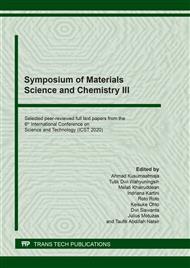p.109
p.117
p.125
p.133
p.140
p.149
p.159
p.165
p.171
Conversion of Nyamplung Oil (Calophyllum inophyllum L.) into Liquid Fuel by Hydrocracking Process Using NiMo/γ-Al2O3 Bimetallic Based Catalyst
Abstract:
The limitations of fossil fuels as one of the non-renewable energy sources in Indonesia make the discourse to create alternative and renewable sources. This research studies the effect of reaction temperature on the hydrocracking process of nyamplung oil into biofuel based on conversion parameters and component selectivity of biofuel products, as well as studying the reaction kinetics of the nyamplung oil hydrocracking process. The research was conducted in two stages, namely the catalyst preparation and the nyamplung oil hydrocracking process. The γ-Al2O3 catalyst was prepared for Ni and Mo metals using the dry impregnation method and then characterized by Energy Dispersion X-Ray Spectroscopy (EDX) showing that the levels in γ-Al2O3 (8.78 wt%) and Ni metals (1.47 wt%), Mo (1.44 wt%), for the surface area of γ-Al2O3 obtained from the Brunauner Emmet Teller (BET) analysis, which is 120.765-185.491 m2.g-1 and the average pore size is 0.229 cc/g. The hydrocracking reaction is carried out in a stirred batch reactor (Model 4563 Parr Instrument Company, 600 mL size) which is a catalyst by 10% of the volume of oil and the reactor is coated with a heating element. Then 300 mL nyamplung oil is put into a batch reactor. Temperature variations between 300-350 °C, reactor pressure 10 bar after gas H2 injected and the reaction time is 2 hours. The best catalyst performance is the NiMo/γ-Al2O3 catalyst 15% ratio of 2:2 with the resulting conversion of 97. 18%. The highest selectivity of bio-gasoline, bio-kerosene, and bio-gasoil was 1.25, 6.07, and 92.68% using a NiMo/γ-Al2O3 catalyst of 15% 2:1 ratio at 350 °C. The main composition of compounds in the bio-gasoil fraction includes n-paraffin, namely pentadecane (C15), heptadecane (C17), and hexadecane (C16), an increase in temperature seems to reduce carboxylic acid compounds and other oxygenated compounds.
Info:
Periodical:
Pages:
140-148
Citation:
Online since:
May 2021
Keywords:
Price:
Сopyright:
© 2021 Trans Tech Publications Ltd. All Rights Reserved
Share:
Citation:


